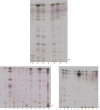Macroalgae of Izmir Gulf: Cystoseira barbata, Cystoseira compressa and Cystoseira crinita species have high α-glucosidase and Moderate Pancreatic Lipase Inhibition Activities
- PMID: 33224246
- PMCID: PMC7667568
- DOI: 10.22037/ijpr.2020.1100953
Macroalgae of Izmir Gulf: Cystoseira barbata, Cystoseira compressa and Cystoseira crinita species have high α-glucosidase and Moderate Pancreatic Lipase Inhibition Activities
Abstract
Hyperglycemia and hyperlipidemia have been symptoms of many serious diseases such as diabetes and atherosclerosis overall the world. Thus, drug researchers have focused on new, natural and healthy drug alternatives. Marine macroalgae is a great source of hypoglycemic, hypolipidemic or hypocholesterolemic agents. In this study, we investigated that hypoglycemic, hypolipidemic and cytotoxic potentials of 22 marine macroalgae from the Gulf of Izmir. According to our results, the cold methanol extract of Polysiphonia denudata exhibited the highest antioxidant activity (93.6%) compared to BHA (95.3%). Three Cystoseira species, Cystoseria crinita (91.9%), Cystoseria barbata (90.7%), Cystoseria compressa (89.8%) showed higher α-glucosidase inhibition rates than oral antidiabetic acarbose (79.5%). It has also been observed that same species are potent inhibitors of pancreatic lipase. Cytotoxicity test revealed that these extracts did not cause viability inhibition on MCF-7. The results of maltose- glucose assay indirectly displayed that Cystoseira cold methanolic extracts inhibited maltose consumption better than acarbose on HT29. The results of this screening study show that these Cystoseira species may provide non- toxic bioactive agents to control non-communicable diseases (NCDs) such as cardiovascular disease and diabetes mellitus.
Keywords: Alpha-glucosidase; Cystoseira; HT29; Inhibitors; Pancreatic lipase.
Figures



Similar articles
-
Macroalgae of Izmir Gulf: Dictyotaceae exhibit high in vitro anti-cancer activity independent from their antioxidant capabilities.Cytotechnology. 2016 Dec;68(6):2667-2676. doi: 10.1007/s10616-016-9991-0. Epub 2016 Jul 4. Cytotechnology. 2016. PMID: 27378181 Free PMC article.
-
Biological potential of marine macroalgae of the genus Cystoseira.Acta Biol Hung. 2015 Dec;66(4):374-84. doi: 10.1556/018.66.2015.4.2. Acta Biol Hung. 2015. PMID: 26616370
-
Antimicrobial and antioxidant activities with acute toxicity, cytotoxicity and mutagenicity of Cystoseira compressa (Esper) Gerloff & Nizamuddin from the coast of Urla (Izmir, Turkey).Cytotechnology. 2015 Jan;67(1):135-43. doi: 10.1007/s10616-013-9668-x. Epub 2013 Dec 1. Cytotechnology. 2015. PMID: 24292649 Free PMC article.
-
Antioxidant, Anti-inflammatory and Antiproliferative Effects of Aqueous Extracts of Three Mediterranean Brown Seaweeds of the Genus Cystoseira.Iran J Pharm Res. 2014 Winter;13(1):207-20. Iran J Pharm Res. 2014. PMID: 24734073 Free PMC article.
-
Coumarin-based Scaffold as α-glucosidase Inhibitory Activity: Implication for the Development of Potent Antidiabetic Agents.Mini Rev Med Chem. 2020;20(2):134-151. doi: 10.2174/1389557519666190925162536. Mini Rev Med Chem. 2020. PMID: 31553294 Review.
Cited by
-
In Vitro and In Vivo Antidiabetic, α-Glucosidase Inhibition and Antibacterial Activities of Three Brown Algae, Polycladia myrica, Padina antillarum, and Sargassum boveanum, and a Red Alga, Palisada perforata from the Persian Gulf.Iran J Pharm Res. 2023 Apr 17;22(1):e133731. doi: 10.5812/ijpr-133731. eCollection 2023 Jan-Dec. Iran J Pharm Res. 2023. PMID: 38116547 Free PMC article.
-
Comparative metabolic study of the chloroform fraction of three Cystoseira species based on UPLC/ESI/MS analysis and biological activities.J Enzyme Inhib Med Chem. 2024 Dec;39(1):2292482. doi: 10.1080/14756366.2023.2292482. Epub 2023 Dec 12. J Enzyme Inhib Med Chem. 2024. PMID: 38086785 Free PMC article.
References
-
- Association AD. 2. Classification. Diagnosis of Diabetes. Diabetes Care . 2017;40:S11 LP–S24. - PubMed
-
- Saito N, Sakai H, Suzuki S, Sekihara H, Yajima Y. Effect of an alpha-glucosidase inhibitor (voglibose), in combination with sulphonylureas, on glycaemic control in type 2 diabetes patients. J. Int. Med. Res. . 1998;26:219–32. - PubMed
-
- Casirola DM, Ferraris RP. α-Glucosidase inhibitors prevent diet-induced increases in intestinal sugar transport in diabetic mice. Metabolism . 2006;55:832–41. - PubMed
-
- Charpentier G, Dardari D, Riveline JP. How should postprandial glycemia be treated? Diabetes Metab. . 2006;32:2S21–27. - PubMed
LinkOut - more resources
Full Text Sources
